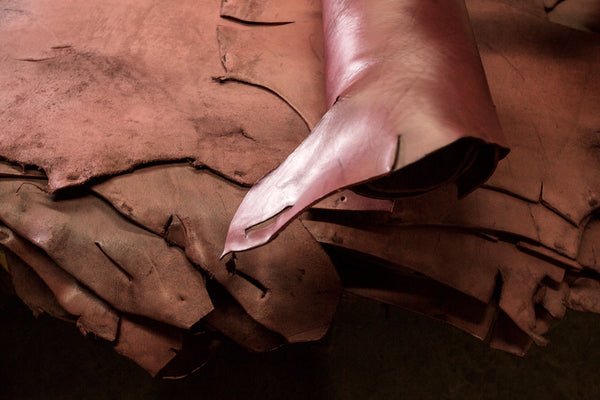Vegetable Tanning - The Complete Guide | Proven Hands
Mar 30, 2025
Vegetable Tanning
Vegetable tanning is one of the oldest and most respected ways to tan leather. It has been used for centuries to create strong, long-lasting leather with a rich, natural look. Unlike chemical tanning, vegetable tanning relies on plant-based tannins to preserve the hide. This creates a rugged, durable material that only gets better with age.
At Proven Hands, we use full-grain vegetable-tanned leather because of its quality. No synthetic coatings, no shortcuts. Just real leather built to last.
What is Vegetable Tanning?
Vegetable tanning is a natural tanning process that uses tannins found in tree bark, leaves, and other plants. These tannins bind to the proteins in the hide, making the fibers strong and preventing decay. The result is a leather that is firm, durable, and rich in character.
Chrome-tanned leather is mass-produced in a matter of days using harsh chemicals. Vegetable tanning takes weeks of careful processing. This slow, natural approach makes a higher-quality leather that lasts for decades.
The Vegetable Tanning Process
The tanning process itself is meticulous and time-intensive. Each hide goes through multiple stages to ensure durability and quality.

-
Rawhide Preparation – The hides are cleaned and soaked.
-
Tannin Bath Soaking – Hides are placed in pits or drums filled with plant-based tannins. This allows them to absorb slowly over time.
-
Gradual Tanning Process – Over several weeks, the tannins bind to the collagen. This strengthens the leather naturally.
-
Drying & Conditioning – The tanned leather is dried, softened with natural oils, and finished for durability.
This traditional method results in a firmer structured leather, compared to chemical tanning.
Why Vegetable-Tanned Leather is Superior
Vegetable tanning is about quality, longevity, and sustainability. Here’s why it stands out:
-
Durability: This leather lasts for decades when properly cared for.
-
Aging & Patina: Over time, it develops a rich, deep patina, making every piece one-of-a-kind.
-
Eco-Friendly: It avoids the toxic chemicals found in chrome tanning.
-
Stronger Structure: The tanning process preserves the natural fibers, making it tougher.
Many mass-produced leather goods today are chrome-tanned. This means they’re treated with chemicals to speed up production. This not only weakens the leather but also harms the environment. That’s why Proven Hands sticks to vegetable tanning. It produces leather that’s stronger, safer, and built to last.
|
Feature |
Vegetable Tanning |
Chrome Tanning |
|
Tanning Time |
Weeks |
1-2 Days |
|
Durability |
Lasts Decades |
Wears out Much Faster |
|
Eco-Friendliness |
Natural Process |
Uses Chemicals |
|
Patina Development |
Ages Beautifully |
Stays the Same |
|
Cost |
Higher |
Lower |
How Vegetable-Tanned Leather Ages Over Time
One of the best things about vegetable-tanned leather is how it gets better with use. Synthetic or chemically treated leather typically stays the same. Vegetable-tanned leather ages with use, developing a patina that tells a story.
When new, vegetable-tanned leather has a light tan or caramel color. Over time, exposure to light, oils, and moisture deepens the tone, leading to a rich brown or deep amber color.
Research has found that all vegetable-tanned leather darkens in sunlight, no matter what tannins are used. This is why vegetable-tanned leather belts from Proven Hands develop a rich color over time.
Most leather goods today are chrome-tanned, but if you want real, full-grain leather that lasts, vegetable tanning is the only way to go.
Caring for Vegetable-Tanned Leather
Taking care of full-grain vegetable-tanned leather makes sure it lasts for decades. It doesn’t take much maintenance, but a few simple steps will keep it in top condition.
-
Keep it Dry: If your leather gets wet, let it air dry slowly and never use direct heat.
-
Condition Regularly: Apply a natural leather conditioner every few months to maintain.
-
Avoid Prolonged Sun Exposure: While some sun is fine, too much can cause premature darkening.
-
Store Properly: Keep in a cool, dry place. For items like belts and wallets, avoid overstuffing them in tight spaces.
If you take care of it, your leather won't only last longer, but it will look better year after year.
Why Proven Hands Uses Vegetable-Tanned Leather
At Proven Hands, we believe in doing things the right way. That’s why we use full-grain vegetable-tanned leather for our belts. No artificial dyes, no cheap coatings.
If you want a belt that gets better with age, check out our full grain leather belts. Each are handmade with 100% made in USA vegetable tanned leather from Wickett & Craig.
When you buy from Proven Hands, you’re getting more than just a belt. You’re backing local craftsmen, honest work, and the American economy.
Built tough and made to last, our belts are made for both the job site and a night out.
FAQ: Vegetable Tanning
Vegetable Tanning vs Chrome Tanning? What's the difference?
-
Vegetable tanning takes weeks and creates firm, durable leather.
-
Chrome tanning is fast but weakens the leather over time.
Why does vegetable-tanned leather darken over time?
The leather absorbs oils, sunlight, and moisture, causing it to develop a rich patina.
Is vegetable-tanned leather better for belts and wallets?
Yes. It’s stronger, lasts longer, and doesn’t contain harsh chemicals.
Can vegetable-tanned leather get wet?
Yes, but water can stiffen or stain the leather. Let it air dry and condition regularly.
Why is vegetable tanning more expensive?
It’s a slow, labor-intensive process that uses higher-quality hides.
Limited Supplies - Don't Wait Too Long!
If you don't want to settle for cheap, mass-produced belts that fall apart, then choose Proven Hands.
There are 3 Proven Hands Full-Grain Leather Work Belts to choose from.
The Classic Belt
Best for: Everyday wear, light-duty work, or casual conceal carry
The Settler Belt
Best for: Heavy-duty use, workwear, or strong conceal carry support
The Pioneer Belt
Best for: Maximum durability, moisture resistance, or frequent heavy load
Follow us on Instagram or join our newsletter for updates and discounts that save you money.







